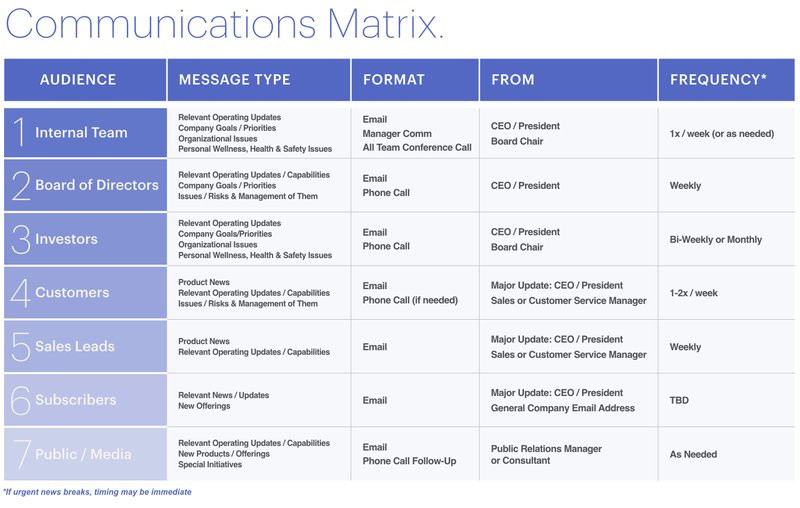In Times of Crisis, Clarity & Brevity Are Key
Best practices for communications of epidemic proportions
As we’ve worked under this cloud of fear and anxiety, we’ve been curious to see how thoughtfully brands have addressed their perspectives and protocols on COVID-19.
Here are a few best practice themes – and a few inspired “don’ts” -- we’ve seen in how brands thoughtfully structure communications to balance knowns and unknowns and establish trust in times of distress.
How to structure your communication
When you engage with your audience, there are a few key points you’ll want to make in order to effectively (and respectfully) communicate in times when stress is heightened and attention is scattered. We recommend keeping things succinct yet honest with the following outline:
Introduction
- Current state of affairs: What we know today
Actionable Information
- What we’re doing about it
- What you can be doing about it
- Timing for these decisions
What’s Next
- Optimistic notes for future
Value Share
- Expression of values to instill shared purpose and collective momentum
Style and frequency of communication
You want to make sure you’re reaching out at the right time and in the right way so that your message is fully received. How often is enough without seeming overbearing or redundant? And when is a phone call more appropriate than an email, and vice versa? Your answers to these questions should be determined by your audience. Consider the following protocols for all your different stakeholders:

(Thanks to our friend Caroline Barni, Chief Marketing Officer at Tech Elevator, for inspiring this helpful framework)
What NOT to include in your announcements
Here are a few of our major DON’Ts:
- The phrase “I just wanted to…” Yes. We know you did, otherwise we wouldn’t be reading this. Please get straight to the point.
- Your opinions or assumptions. Stick to the facts, ma’am. This is no time for pontification.
- Lengthy paragraphs: Understand that your audience is taking in a lot of information at this time. Their minds – and their eyes - are tired. Give them the courtesy of your primary messages, at a glance.
- Statement of the Obvious: Oh, we’re in unprecedented times? I wasn’t aware.
- Drip Campaign Triggers: This is the time for thoughtful, human-to-human communication, not automation. Call off your bots and try adding a phone number or direct email instead.
- Non-actionable updates: Avoid any chance of your audience thinking, “OK, so now what?” by providing a strong call to action about what to do (or not do) in relation to your communication.
- Prioritization of profit: Consider the hierarchy of your messaging. It’s not that you can’t mention your products or services, but they should be mentioned briefly and shouldn’t be the primary focus of the outreach.
Other best practices
- Be honest. Audiences embrace authenticity and vulnerability now more than ever before.
- Bold key statements. Assume that your audience is being bombarded with similar communication and won’t take the time to read every word you write. Make the purpose of your announcement the first thing they read, especially if it appears in the body copy.
Share-worthy examples:
From our friends at Harness Cycle:
Based on this guidance, our leadership team has made the decision to temporarily suspend all Harness Cycle studio operations effective immediately.
After announcing closure of its trails, Cincinnati Nature Center ended on an optimistic note that reinstills core values:
We appreciate your understanding and continued support of the Nature Center. We encourage you to continue to get outdoors within your backyards and neighborhoods. This crisis shall pass, and we'll be so grateful to welcome you back to our beautiful trails. I think, at that point, we'll all need some time to relax and reconnect in nature.
Clothing brand Miista briefly mentioned its new offerings at the end of its newsletter, but only in full context of the broader circumstances we’re all facing:

Be YOU, but be quick about it
The need for brand authenticity doesn’t go away, even during pandemics. Your audiences want to know you’re still you, but ultimately, they want to know you’re conscious about what’s top of mind for all of us right now. Use the strategies in this post to ensure loyalty and success once we’re safely on the other side of uncertain times.
About the Author
Alex is the Content Manager at Muse. In this role, she develops editorial strategies brand stories and press pitches that fuel Muse clients’ marketing activities. Prior to Muse, she worked as a content marketer and strategist for nonprofits and large corporations, including University Hospitals, Flash Seats® and the Council of Smaller Enterprises (COSE). She earned her Master’s and undergraduate degrees from University of Dayton.
More Good Reads

Modern Wellness Customer Personas: 2025
How to target different wellness motivations of consumers, updated for 2025.

Your Marketing Playbook for Consistent Planning & Execution
Gain direction & cohesion for your marketing efforts using our free marketing playbook. Save your marketing department time & resources.

